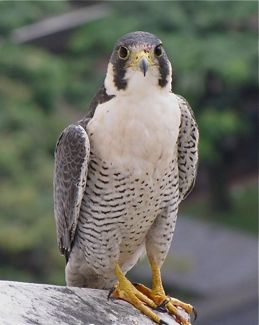“The sight of common house crows perching on TV antennae of high rise apartments in Singapore is familiar to all. How about that of the Peregrine Falcon (Falco peregrinus)?” ask Sun Chong Hong.
“On 24 Feb 09 at about 6.30 pm, I saw a bird flying towards a 25 storey HDB block in Bishan near to the Bishan Park. At first I thought it was a house crow. After a short while, I realised I was mistaken because the way the bird flapped its wings was different from that of the crow. While crows flap their wings more gracefully and look more flexible, the movement of this bird’s wings appeared to be stiff. It landed and perched on the antennae and started to preen itself.
“For the next 7 days or so, the bird would come and land on its perch between 6.30 pm and 7 pm. However, since yesterday (4 Mar) the bird was no longer seen.”
According to Tudge (2008), “Peregrines are taking to city life worldwide. For them, the towers are cliffs – just right for nesting; and there are pigeons aplenty to feed on.”
It seems that in Singapore, they are getting common, especially during the winter migratory months, although a few are also seen during the non-migratory season as well. According to our bird specialist R Subaraj, “based on colouration and size, these birds are believed to be visitors of the resident race from some place nearby, like Malaysia. These falcons are often found on transmitter towers, including Bukit Batok, Sentosa, Ubin and even Fort Canning. These structures offer a good vantage point, feeding and roosting perch.”
There are always plentiful mynas and starlings to provide food for these raptors in urban and rural areas. See also below.
Image by Kwek Swee Meng.
Reference:
Tudge, C., 2008. Consider the birds. Who they are and what they want. Allen Lane, London. 480 pp.










4 Responses
Additionalpest controllers to keep the mynahs in check
After note: the Peregrine Falcon continued to be seen regularly at the same perch, sometimes in both early morning around 7.30 am and in the evening, until end of April.
Hi,
Urban Peregrines often hunt at night – especially during the migration seasons…you might want to return at dusk to see if that Peregrine gets active after dark (it is cooler then and darkness increases their ability to hunt undetected).
rdc/nyc
Hi Robert
The Falcon I sighted here always leave, presumably to roost elsewhere before total darkness fell. There are plenty of trees in the area. Waves and waves of pink-necked green pigeons, totaling perhaps in the hundreds, can be seen arriving at dusk before they settle in their roosts. There are also plenty of other common birds of Singapore, such as mynahs, asian glossy starlings, pigeons here. With food aplenty around, the Falcon may not need to hunt in the dark.
By the way, I didn’t have the luck of seeing the Falcon pursuing its prey.